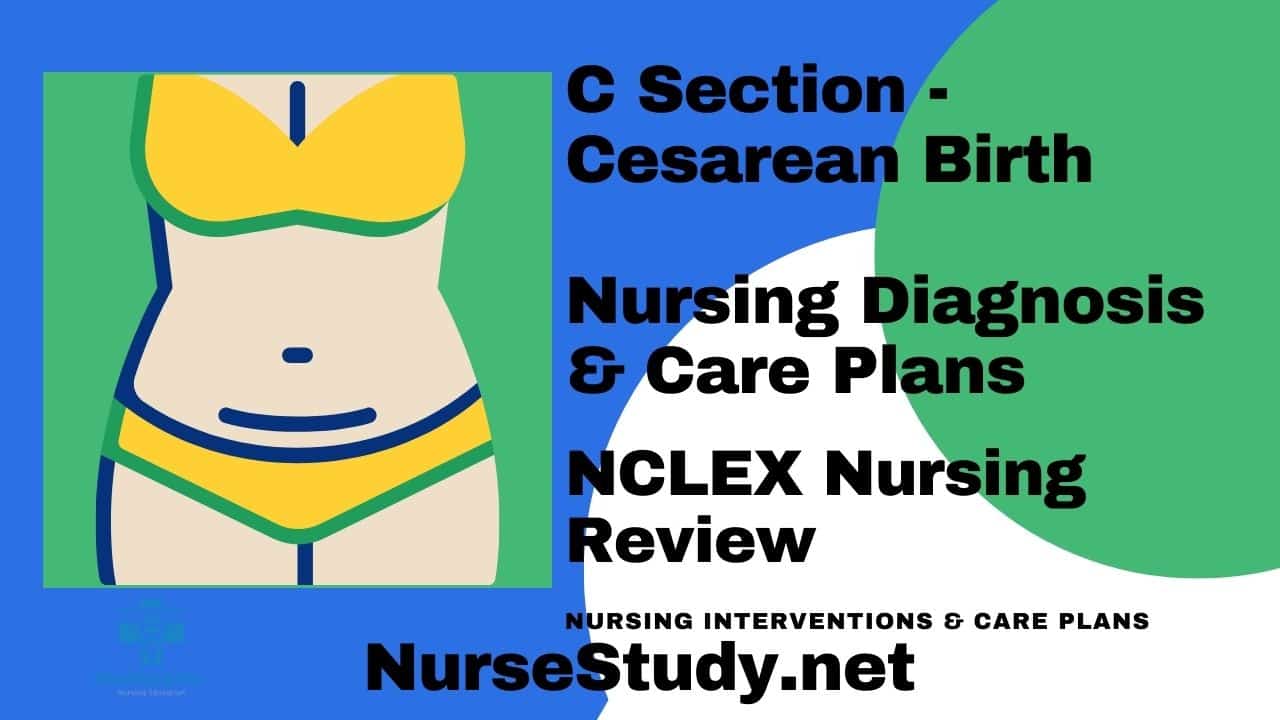
C Section NCLEX Review and Nursing Care Plans
A cesarean section, C-section, or Cesarean birth is a surgical method of delivery by making an incision in the mother’s abdomen and the uterus. It is used by healthcare professionals when they believe it is beneficial for the mother, the infant, or both.
The incision in the skin could be a:
1. Vertical Incision (Up and Down). This incision runs from the navel to the pubic hairline.
2. Horizontal Incision (Across from side to side). This incision runs throughout the pubic hairline. It is the most commonly used since it recovers well enough and causes minimal bleeding.
The incision utilized is determined by the mother’s and fetus’s health. The uterine incision might either be horizontal or vertical.
Furthermore, several women request cesarean birth for their first babies to prevent labor pain or the potential risks of natural birth or benefit from a planned delivery’s comfort. However, if the mother intends to have multiple children, this delivery is discouraged.
Women who have had several C-sections are more likely to suffer placental issues and excessive bleeding, which may necessitate complete removal of the uterus (hysterectomy).
If a scheduled C-section is being considered for the mother’s first delivery, she should consult with her health care practitioner to decide what is best for her and her baby.
Before undergoing surgery, the female patient must go through the diagnostic procedures advised by her doctor. Here are a few examples of diagnostic procedures:
Below are some of the postoperative management procedures that the pregnant patient needs:
Deficient Knowledge
Nursing Diagnosis: Deficient Knowledge related to inadequate exposure, unawareness of the illness and information resources, and information misunderstanding secondary to C-section or cesarean birth as evidenced by confusion about narrative, improper behaviors, and insufficient comprehension of guidelines.
Desired Outcome: The client will articulate her awareness of the reasons for cesarean birth and postoperative expectations and will identify this as an alternate childbirth procedure in order to obtain the greatest possible outcome in the end.
Acute Pain
Nursing Diagnosis: Acute Pain related to intensified muscle contractions, psychological responses, surgical injury, and distention of the bladder or abdomen related to C-section or cesarean birth as evidenced by reports of discomfort, protective or distracting behaviors, nervousness, sobbing, yelling, agitation, arrhythmia, and tachypnea.
Desired Outcome: The patient will verbally express diminished discomfort or pain, seem tranquil, be able to rest or sleep, and interact adequately.
Powerlessness
Nursing Diagnosis: Powerlessness related to interpersonal communication, illness-related control, and helplessness lifestyle secondary to C-section or cesarean birth as evidenced by manifestations of helplessness in the face of adversity, lack of involvement in decisions about care regime and apathy.
Desired Outcome: The patient will convey specific wants and desires, anxieties, and vulnerability and contribute to decision-making wherever possible.
Nursing Diagnosis: Anxiety related to actual or perceived harm to mother and fetal well-being, situational dilemma, a threat to one’s self-concept, and the emergence of complications secondary to C-section or cesarean birth as evidenced by wariness, despair, unworthy feelings, excessive tension, nervousness, sympathetic activation. and worries about the consequences.
Desired Outcome: The patient and her spouse will discuss their concerns, will appear relaxed and confident, will communicate concerns for the infant’s safety, and will finally exhibit lessened anxiety after discussing C section or cesarean birth.
Risk for Ineffective Self Health Management
Nursing Diagnosis: Risk for Ineffective Self Health Management related to inadequate individual coping secondary to post-C-section procedure, a complicated therapeutic regimen, and conflicts with spiritual principles or cultural influences.
Desired Outcome: The patient will determine objectives for optimal health management related to post C-section. She will exhibit positive behaviors to adopt a therapy regimen into daily life, and express understanding of the treatment protocol.
Ackley, B. J., Ladwig, G. B., Makic, M. B., Martinez-Kratz, M. R., & Zanotti, M. (2020). Nursing diagnoses handbook: An evidence-based guide to planning care. St. Louis, MO: Elsevier. Buy on Amazon
Gulanick, M., & Myers, J. L. (2022). Nursing care plans: Diagnoses, interventions, & outcomes. St. Louis, MO: Elsevier. Buy on Amazon
Ignatavicius, D. D., Workman, M. L., Rebar, C. R., & Heimgartner, N. M. (2018). Medical-surgical nursing: Concepts for interprofessional collaborative care. St. Louis, MO: Elsevier. Buy on Amazon
Silvestri, L. A. (2020). Saunders comprehensive review for the NCLEX-RN examination. St. Louis, MO: Elsevier. Buy on Amazon
Please follow your facilities guidelines, policies, and procedures.
The medical information on this site is provided as an information resource only and is not to be used or relied on for any diagnostic or treatment purposes.
This information is intended to be nursing education and should not be used as a substitute for professional diagnosis and treatment.
Anna Curran. RN-BC, BSN, PHN, CMSRN I am a Critical Care ER nurse. I have been in this field for over 30 years. I also began teaching BSN and LVN students and found that by writing additional study guides helped their knowledge base, especially when it was time to take the NCLEX examinations.